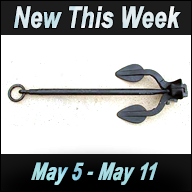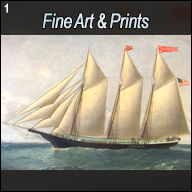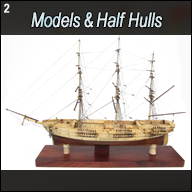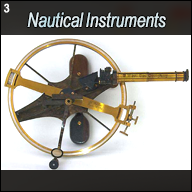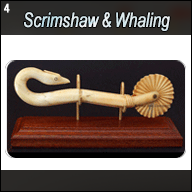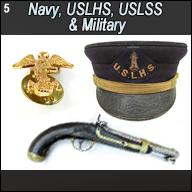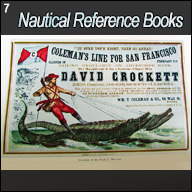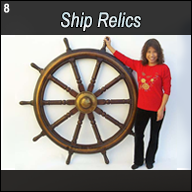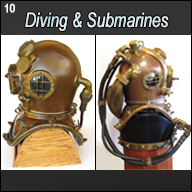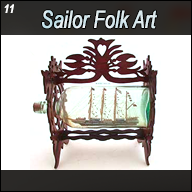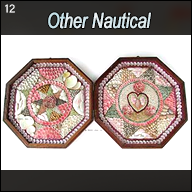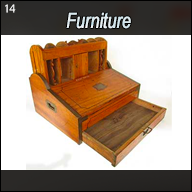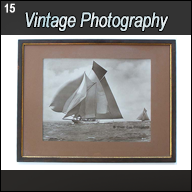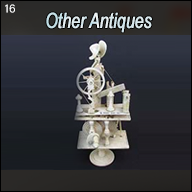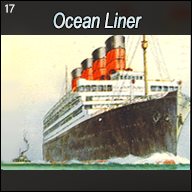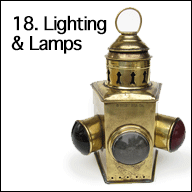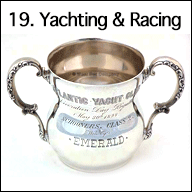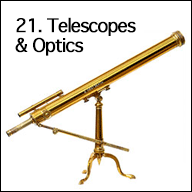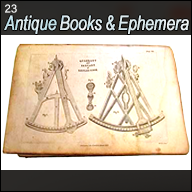Hall of Fame
OUTSTANDING NAUTICAL ANTIQUES AND ART SOLD FROM THIS WEBSITE
Page 4 of 7
Pages « 1 2 3 4 5 6 7 »
IMPORTANT AMERICAN PAINTING. Solon Francis Montecello Badger, American, 19th/early 20th century, oil on canvas portrait of the large 4-masted schooner PERRY SETZER returning to port with headlands and a lighthouse in the distance. This impressive ship's portrait depicts the magnificent schooner in a traditional broadside view under full sail with several crewmen on deck. Execution is of the highest order with the minutest of details precisely portrayed. The painting is clearly signed lower left, "S.F.M. Badger, Charleston, Mass." and is again boldly signed on the reverse "S.F.M. Badger, Charleston, Mass." with large black painted letters in the artist's hand. This lovely painting is a delight to the eye, bringing the rich color of this famous marine artist's palette to a superb level. It measures 22 by 35 1/2 inches sight on its original stretcher, and is housed in its fantastic original ornate gilt gesso frame that measures 28 by 42 inches. Condition of this painting and frame are nothing short of amazing! They are in absolutely untouched original condition. The painting has NOT been relined and inpainting as revealed under black light inspection is limited to 2 tiny spots of inconsequence. Complete with original documentation from the ship's captain and launching photo! A museum quality offering!!
The large 4-masted American schooner PERRY SETZER, call sign "K.R.T.B." was launched in Bridgeport, Connecticut in 1902. She was a vessel of 217 feet in length with a gross tonnage of 1,392.
This painting, along with original documentation, comes from the estate of her former Captain, Charles Wesley Blake, of Pleasantville, New Jersey. Complete with this ship's portrait is an original albumen photograph of her launching. Also included are 4original pages outlining the long and distinguished Service Record of Captain Blake, showing his service aboard the SETZER at the time of her launch in 1902 and again for the period of February 1904 through July of 1906.
RARE AMERICAN SEXTANT. Magnificent 3rd quarter of the 19th century American fretwork frame sextant made by the prestigious New York makers "T.S. & J.D." Negus as beautifully hand-engraved on the brass arc. This class A sextant is one of the finest we have ever had the pleasure of offering. It has an inlaid silver scale calibrated from 0 to 150 degrees (in actuality making this a quintant) subdivided in incredibly fine 10 arc minute increments! The silver vernier is left reading from 0 to 10 providing a reading accuracy down to an amazing single arc minute! This lovely instrument has a braced all bronze frame with a massive solid ivory handle! The handle is intricately etched to provide for a sure grip and is attached to the frame by means of 3 graceful support arms. In addition to these assets, this sextant has several other features which speak of its quality. The index arm is equipped with a vernier magnifier set atop a delicate swinging arm. Attached to the arm is a pivoting glass window which may be adjusted to reflect the maximum amount of light onto the scale for reading. The horizon mirror box is fitted with two trunions which allow it to pivot and to be adjusted with a knurled thumbscrew housed within yet another protective knurled tube. We have never encountered this complex feature on any other sextant! In addition, both the index and horizon mirrors have similar smaller protective tubes which house small screws for making fine adjustments to the plane of the mirrors! This sextant has its full compliment of index and horizon filters and both mirrors are in tact. The sighting tube holder is adjustable for height using a large finely knurled knob. The index arm stop and fine adjust knob have similar precision action and fine knurling. The entire unit is housed in its original hand dove-tailed mahogany box with all brass fittings, including flush folding brass handle, box lock and original key! It is complete with the usual compliment of sighting tubes including non-optical peep tube, short non-inverting telescope, long inverting telescope with cross hairs, one screw-on sun filter, and a brass adjusting wrench. Within the lid is the old label of "Eugene F. Medinger & Son Dealers in CHRONOMETERS, and Nautical Instruments at 115 Broad Street, New York" stating "All kinds of Nautical Instruments Repaired in the best manner. In summary this instrument must rate as one of the finest of it type we have ever seen offered and would make a premier showpiece for any of the finest nautical instrument collections.
Thomas Stewart and John D. Negus were highly respected nautical instrument makers and were arguably the leading makers in the United States during the second half of the 19th century. Trained in England, the brothers began their manufactory in New York City in 1848. They moved to 100 Wall Street, New York City in 1864 and formed their navigational instrument making firm, "T.S. & J.D. Negus," in 1869. According to research of period U.S. Navy records, T.S. & J.D. Negus chronometer number 640 was sent by the Negus brothers to the Navy for a one-year trial in 1856. In the 1886 U.S. Navy trials conducted at the Naval Observatory Washington D.C., 47 chronometers were tested. Of the 12 accepted, 8 were by the brothers Negus. The firm continued under the trade name "Negus" as a nautical instrument manufactory and retailer well into the 20th century.
The quality of this sextant rivals any we have seen of the period, by makers of any nationality. It is a testament to American ingenuity that the state-of-the-art in instrument making had reached full bloom in America by the 1870's. Undoubtedly this exquisite example of the instrument maker's art was actually made at the hands of the then veteran makers with some 25 years experience.
DECORATIVE SHIP'S MAST TRUCK. Very rare carved wooden ship's mast cap in the form of a plumed helmet. This beautifully executed 19th century carving is hewn from a solid block of pine and done in full relief with fine detail. It is in its original gold, black, and red paint with a nice weathered surface. The carving itself is 6 1/2 inches tall by 7 1/2 inches wide and is in outstanding original condition. Complete with custom-made solid teakwood stand with felt bottom. The entire presentation measures 12 inches tall. A beautiful, extremely rare, museum-quality display piece!
In the reference work entitled "Shipcarvers of North America," 1962, Barre Publishing Co., Barre, Mass., M.V. Brewington documents a variety of carved wooden masthead decorations or "trucks," including a similarly helmeted warrior on horseback.
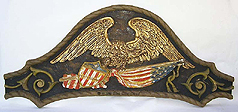
|
SHIP'S STERNBOARD. Late 19th or very early 20th century genuine ship's carved sternboard with a classical patriotic American motif. This beautifully executed example of the shipcarver's art features a large and fierce spread winged American eagle perched atop draped American flags and a Union shield. Each side is adorned with deep carved acanthus scrolls and the entire board is finished with a realistic rope-carved border. The backboard is of typical laminated pine construction. The eagle retains most of its original gilded surfaces and the remainder of the board shows original paint with expected wear and a great old look. The board measures 30 inches high by 67 inches long and is in an excellent state of preservation with no major chips, cracks or losses.
Provenance: Coastal Maine. In the present collection since 1983.
CANNON SUN DIAL. Rare, 19th century sun dial with highly desirable "local apparent noon" signaling cannon. This authentic sun dial is constructed entirely of brass and is mounted atop a marble plinth engraved with the hours of the day in one half hour increments from 5 A.M. to 7 P.M., and with the Latitude designation "36.49'30"." The middle of the dial is fitted with a shadow gnomon for reading the time of day. The cannon is surmounted by a pivoting bipod support which mounts a magnifying glass. The elevation of the glass is made adjustable to the sun's altitude by pivoting across the arcs, one of which is calibrated with the months of the year. With the proper month set, the arms are locked into position by means of the knurled thumb screws on each side. In operation, when the sun reaches its highest point during the day (local apparent noon) the rays of light are focused by the magnifier onto the touch hole of the charged cannon, setting it off with a loud report signaling mid-day! Excellent original condition with nice old bronze patina. The marble base measures 6 1/2 inches in diameter. Still functional. Circa 1850.
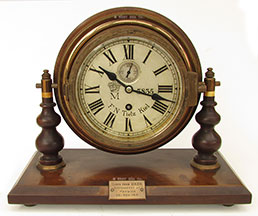
|
WWI GERMAN U-BOAT CLOCK. AN INCREDIBLY RARE HISTORIC RELIC -- A genuine, identified U-boat clock from a surrendered World War I German submarine! This magnificent clock has a bold silvered brass dial with Roman numerals, large spade hands, and a seconds bit under "XII." It is signed (engraved) "F. N. Tietz, Kiel" and bears the serial number "3835" to the right and the German Navy's mark of the "M surmounted by the Kaiser's crown on the left. This exceptional quality clock has a heavy glass crystal covering its hinged and locking bezel -- the winding key also serving as the bezel locking key! Internally, the movement is of the finest quality having solid brass construction with jeweled pivots and matching case and movement serial numbers. The solid brass case measures 9 1/2 inches in diameter overall and has fittings on the back where it would have been originally attached to the bulkhead in its submarine home. Now, as a prize of war, it has been beautifully mounted onto a brass and Bakelite stand with ivory supports. The stands has brass ball feet and measures 14 inches wide by 7 inches deep. Mounted to the front of the stand is the hand-engraved brass presentation plaque reading "CLOCK FROM U.B.80. SURRENDERED AT HARWICH 28. NOV. 1918." This incredible war relic is an outstanding state of preservation and is in top running condition. It has just enough patina to reveal its age to the causal observer. This is truly an amazing offering -- one of the most spectacular to come on the market in recent times!
A number of U-boats were surrendered to the British Government by the German Navy as required by the Armistice signed in the Hague on the famous date of 11-11-18, now Veteran's Day in the U.S. Research is on-going as to the significance of submarine UB-80.
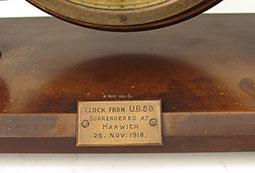
|

|
IMPORTANT SHIP IN A BOTTLE. Rare and unique bottle diorama comprising an identified major liner AND a ship in a bottle within the bottle! This early 1900's example of sailor folk art consists of a large and detailed model of the passenger ship identified as the "BERGENFJORD" on both sides of the bow. She flies the Norwegian ensign from the stern, the American flag from the foremast and the house flag of the Norwegian-American Line from the aft mast. The model is incredibly well detailed with stacks, life lines, deck machinery, cargo hatches, steam whistles, funnels, life boats, deck houses, doors, portholes, standing rigging, Marconi antenna, running lights and search light all meticulously portrayed! The ship plies a blue putty sea and is depicted passing the coastline with jagged rocks to port. On the rocks is a fort complete with guns, a small building and red striped buoy. All of this is contained within the large, early hand-blown wine bottle of thick old glass with a greenish tinge. Indicative of the sailor's abilities as a superb ship in a bottle artisan, the model completely fills the bottle, with both masts touching the sides and the fantail flag touching the bottom. The pièce de résistance of this presentation is the inclusion of yet a second ship in a bottle within the ship in a bottle! It consists of a miniature wooden 3-masted sailing ship complete with yard arms, bow sprit and masts in a tiny old glass medicine bottle measuring less than 2 inches long and 3/4 inches thick! We have never seen this complication in an antique bottle model before. The stoppered miniature bottle is attached to the the cork inside the larger bottle. The entire presentation measures one foot long and 3 1/2 inches in diameter. Outstanding, untouched original condition showing good age. Certainly one of the best examples of sailor folk art ever offered for sale -- an example worthy of the finest museum.
The grand Norwegian liner BERGENSFJORD was built by Cammell, Laird & Co., Ltd., Birkenhead, England for the Norwegian-America Line and launched in September 1913. She had a length of 530 feet, displaced 11,000 tons and accommodated 1000 passengers. Engaged in the Oslo-Copenhagen-Bergen-New York service, BERGENSFJORD was one of the few pre-War liners to maintain uninterrupted passenger service during World War I. However she did see service as a troop transport during the Second World War. After war duties she was renamed twice and continued faithful passenger service until her demise in 1959 at the hands of Italian salvers.
SAILOR'S VALENTINE. Very rare, possibly unique 19th C. shellwork valentine from the island of Bermuda. This folk art shellwork is done in the traditional manner, very much resembling the more common examples from Barbados. However several differences exist. Most noticeably the case is of square Spanish Cedar construction whereas Barbadian valentines are octagonal. The varieties of shells used are slightly different as is the manner in which they are arranged and their borders fashioned. This colorful valentine measures 9 inches square and is in excellent original condition showing good age. There is one age split to the one piece wood panel backing which is not noticeable when displayed. A strikingly colorful one-of-a-kind example!
Norman Flayderman, in his famous book "Scrimshaw and Scrimshanders, Whales and Whalemen," N. Flayderman & Co., New Milford, CT, 1972, notes on p. 279, "A few sailor's valentines have shell arrangements spelling out the inscription: "A Present from Barbados" which further supports the valentines as products of that port. It is interesting to note, too, that there are no specimens marked with any other place name." --- Except one!.
IDENTIFIED SHIP'S FIGUREHEAD. Spectacular 19th Century carved and painted wooden ship's figurehead from the North American bark EDINBURGH. This stunning example of the ship carver's art is dressed in classical attire, adornmed with a ribbon-carved gilt necklace and tiara, central oval brooch and bracelets on each wrist. She poses a striking stance, forward leaning with her right arm across her bosom as she stands on the original base, flanked by Acanthus scrolls. This important artifact was sculpted by the well known Canadian wood carver John Rogerson (1837-1925) who worked in St. John, New Brunswick in the second half of the 19th century. The figurehead stands 73 inches tall inclusive of its small wooden display pedestal and weighs approximately 400 pounds. It is in an outstanding state of preservation with approximately 90% original surfaces and paint.
The EDINBURGH was a Canadian-built and registered 3-masted barque of 203 1/2 feet launched by William Charland, Jr. of St. Joseph de Levis Quebec, Canada in 1883. After 26 years of service, she met her demise in the port of Bermuda where she foundered in 1909. This figurehead was first owned by the American Consul to Bermuda, William H. Allen and was proudly displayed in his garden for several years. In the 1920's she became the property of Francis Turnbull Meyer, a successful businessman from New York. Mr. Meyer, long a patron of the arts, donated the figurehead to the Addison Gallery of American Art at the Phillips Academy, Andover, Massachusetts in 1933 where it was on public exhibit in the Maritime Wing until 2002.
This famous figurehead is well documented in associated literature. In the book "Shipcarvers of North America," M.V. Brewington, 1962, Barre publishing Co., Barre, Massachusetts, the entire page 94 is devoted to a full length photograph of the figurehead with accompanying text. In the landmark work "Treasury of American Design" by Clarence Hornung, published by Abrams, Inc., New York, 1976, the first chapter is entitled "Forgotten Figures Fore and Aft." The frontispiece of chapter I, page 6, is the full page image of this beautiful figurehead
EXCEPTIONAL CHRONOMETER. Truly phenomenal early 19th century chronometer made by one of France's premier horologists, Henri Motel of Paris. This superlative machine has a matte silvered brass dial as done in the French tradition. It is signed "DEPO PT DE LA MARINE" in block letters; then in script "Hr Motel Hger dela Marine Rle" and numbered "N 159" within the seconds bit. The dial is marked with Roman Numerals and bears blued steel Breguet type hands that are best described as "works of art!" This early one day chronometer has a convex domed crystal and a flat bezel with sliding dust cover on the right which exposes the winding arbor. One of the remarkable traits of Motel's work was his innovativeness. It is exemplified here with his signature "front wind" device, specified by the French Navy, which allowed the chronometer to be wound without turning it over as required by virtually all other chronometers. Equally unusual is that this chronometer is not gimbaled but mounted much like a deck watch in a two tiered mahogany box with piano hinge and button latch. The movement is a thing of beauty and a testament to Motel's skill and knowledge. At its heart is the pivoted detente escapement and a constant tension fusee. The very unusual 4-arm bimetallic balance is unique to Motel's output, and is housed in a very elaborate balance bridge. The steel helical hairspring, while period 19th century, is not of the conical style and in our opinion might be a quality early replacement. Also the hairspring was once fitted with an On/Off feature in response to the French Navy's request that their chronometers be fitted with balance locks. This is evidenced by the complex means of attachment of the hairspring to the potence and the existence of the engraved markings "A" and "M" on the periphery of the chronometer bowl which stood for "arret" (stop) and "marche" (run). Certainly this added complication, on a machine that by definition was to run continuously, was later adjudged to be unnecessary if not downright dangerous, and was subsequently removed. This incredible example of the early French horologer's art is extremely rare and valuable in an outstanding state of repair. Circa 1831. Complete with lovely diminutive chronometer winding key.
Jean Francois Henri Motel was born in 1786 and died in 1859. He worked at Rue de l'Abbaye, Paris from 1830 to 1840 and Rue du Foin until 1850. He studied under the two legendary French horologers, Louis Berthoud and Abraham Breguet. He succeeded Breguet as "Horologer de la Marine" to France in 1828. According to Tony Mercer in "Chronometer makers of the World" Motel only made 85 chronometers in his 30 year career! His nephew, Onesime Dumas, a renown horologer in his own right, was apprenticed to his uncle.
In Hans von Bertele's book "Marine & Pocket Chronometers," English version by Schiffer Publishing Co., West Chester, Pennsylvania, 1991, at least 7 of Motel's chronometers are described and pictured in detail. Beginning with figure 190, the first is number "25," dating circa 1820, which is in the Time Museum, Rockford, Illinois. It is configured in a very similar two-tiered non-gimbaled box. Number "38," described as pre-1823, is in a gimbaled box but with a dial and bezel virtually identical to the one offered here. Motel's number "44" is similar to number 38. Next described is Motel's number "103." The caption reads "Dial of a marine chronometer in mahogany case without gimbal mounting, signed "Hri Motel Hger de la Marine Rle No. 103", Paris, ca 1830; with lever in brass ring around the dial winding arbor under it. Rear view of the movement of Motel's marine chronometer no. 103, with conical balance spring, chain and fusee. Pivoted detente after L. Berthoud and three armed compensation balance with 18,000 beats per hour." The next is his number "106" which differs from 103 in escapement and now bears a 4 arm balance. Figure 227 shows Motel's number "257" and describes it as "Movement of Motel's marine chronometer, refined, richly structured construction, barrel with chain and fusee, separate balance assembly, four-armed compensated balance with conical hairspring and special adjustable attachment of the spring's terminal curves. This configuration appears to be the closest to the example offered for sale here. Finally Bertele depicts as figure 240, Motel's number "276" dated at circa 1845 and also configured in a two-tiered box.

|

|
CAMPAIGN CHEST OF DRAWERS. Important late 18th or early 19th C. campaign-type chest of drawers constructed of SOLID rosewood! This chest on chest is of English origin and was made in two sections with hand-wrought iron handles on the sides so as to be easily carried on and off ship. The fronts of the drawers have the original flush inlaid brass drop handles and each drawer retains its original brass skeleton lock. All of the drawer facings consist of one piece rosewood panels with edge beading and are meticulously hand dovetailed to hand hewn solid mahogany drawer panels. Remarkably the backs of each chest are fitted with single mahogany backboards measuring 20 inches wide and 42 inches long! Equally remarkable is the top of this handsome chest which is made from a single rosewood panel 15 inches wide, by 42 inches long and 3/4 inch thick. The sides are the same hefty construction. Of special note are the superb carved rosewood "ropework" edges on the top, bottom, sides, and on the four feet. As shown, this chest measures 44 inches high, 44 inches wide and 18 inches deep. It is in very fine original condition, considering its great age, and exhibits good wear and patina. One very old chip, 8 inches long and 1/2 inch wide, does exist in the bottom left rear panel. However, its location on the chest makes it unnoticeable. This is a very heavy, stout chest that will undoubtedly last another 200 years! Rare!
FAMOUS OCEAN LINER MODEL. Fine, expertly crafted period model of the famous grand old passenger liner the RMS AQUITANIA as identified on the bow and stern. This beautiful waterline model is composed of a sculpted wooden hull, superstructure, deck houses, and funnels, with all metal deck fittings and stenciled paper details applied to the cabins. The detailing is really quite remarkable for a model of this size, which measures only 17 3/4 inches long and 4 inches high, exclusive of the base. The complicated array of deck equipment originally fitted on this huge ship is very well represented in this model including numerous ventilators, davits, hatches, cargo booms, winches, bitts, chocks, companionways, deck lockers, stanchions, guard rails, etc. Each of the myriad lifeboats is sculpted of wood. The large number of lifeboats on this ship is indicative of the time when it was built -- only 2 years after the TITANIC disaster, when the great loss of life was at least partially attributable to an inadequate supply of lifeboats. While it is likely that this is a production model, there can be no doubt that it was almost entirely hand made. The detail of the rigging, especially the funnel guys, and the paint work topside speak of hours of meticulous detail work not seen in any but the finest of such models. Because of the precision and construction methods, this model most certainly dates prior to the First World War. It is mounted to its original solid mahogany base which measures 22 1/4 inches long and 3 3/4 inches wide. It is fitted with a reinforced glazed case. The entire presentation is in excellent original condition with old surfaces throughout, noting some dust, patina, and effects of age. In our opinion this is one of the finest old models of its type to be found. It would certainly make a prized focal piece of any quality collection of ocean liner memorabilia.
The grand lady RMS AQUITANIA, was the last four-funnelled Atlantic liner and was considered by many to be the most beautiful ship ever built. At 902 feet in length, she was also the 14th largest passenger vessel ever constructed, beating out TITANIC by 20 feet! She was built by John Brown & Co., Glasgow for the Cunard Line, homeported in Liverpool. She entered the Liverpool-New York trade on May 30, 1914. After only three voyages she was commissioned as an armed merchant cruiser and entered the Great War as a hospital and troop ship until 1919. Between the wars she saw merchant service in the Atlantic, only to be recommissioned as a troopship again in 1939. After World War II she saw brief merchant service carrying war brides and immigrants to Canada. She was broken up in 1950. (Frederick Emmons, "The Atlantic Liners," 1972, Bonanza Books, New York.)
YACHT BINNACLE. Superb, extremely ornate American yacht binnacle from the second half of the 19th century with the top cap hand-engraved "Riggs & Brother Phila." This all brass binnacle contains the original compass with compostion card marked in points to an accuracy of 1/32nd points and addtionally calibrated in single degrees. The fleur-de-lis is marked "PATENTED Jan 21st 1871, Aug 17th 1875 Ritchie, Boston, U.SA." The compass ring is stamped "E.S. Ritchie 24379 Boston." The binnacle stands 34 1/2 inches tall and 14 1/2 inches wide, with a heavy, ornately cast solid brass base and no compensating spheres, indicative of its use aboard a wooden-hulled sailing vessel. The bulbous "mushroom hood" retains both original oil burning side lanterns with "Simplex" burners signed "E. Miller Co., Meridian, Ct." Excellent original condition throughout with old lacquered surfaces showing good age and nice patina. A most desirable and decorative example of a functional navigational instrument from the 1800's embodying a concerted production effort by 3 of America's foremost nautical specialists of the era.
The firm of Riggs and Brother, nautical instrument makers, was listed at 221 Walnut Street Philadelphia in 1877.
POLITICAL PRESENTATION CANE. Very handsome gentleman's walking stick with repoussé gold tooled handle bearing the engraved inscription "From 21 Senators to HON. WM. FIELD, their Presiding Officer. A testimonial 1855." This lovely presentation piece has a delicately tapering shaft formed of solid, exotic, snakewood terminating in the original brass ferrule with iron tip. The handle, while not hallmarked, tests positively for 18 kt gold. Obviously we are not selling this fine stick for any gold content, but its wonderful historical significance. 35 1/2 inches long. Virtually mint condition. Probably never used, only displayed with pride. An important relic of American pre-Civil War history.
CAPTAIN'S LIQUOR DECANTER SET. Very handsome early to mid-19th century gentleman's portable liquor cabinet of the type used by ships' captains at sea. This unusually fine quality set contains 4 cut glass lead crystal decanters with matching fitted stoppers. Each decanter is hand-blown and numbered, corresponding with its diamond faceted, numbered stopper, all of which fit their numbered compartments within the case. The case itself is a work of art with a gold tooled red leather interior and a magnificent exterior in brass-bound exotic burled walnut. It features a lid with brass corners, brass finished edges and inlaid shield. The sides are inset with flush folding brass handles and all four bottom corners are brass-bound. The wood surface is in excellent condition, noting a few very minor surface cracks as expected with burled wood. The hinged case is also complete with its original lock and striker plate with inlaid shield escutcheon and inset front brass lifting notch. Overall condition is absolutely outstanding, very well cared for and totally serviceable. The case measures 8 1/4 inches square on the top and 9 inches high. A truly spectacular set. Cheers!
IMPORTANT EARLY TELESCOPE. Museum quality, late 1600's or very early 1700's mariner's 3 draw telescope signed "Oliuo, Venezia" on the textured vellum main tube. This exceptional early telescope is constructed of vellum (hard paper suggestive of lambskin) with an embossed floral design fitted with end caps of decoratively turned horn with a telling early style "nipple" eye cup. The original simple optics are of the monochromatic type with turned boxwood retainers, producing a magnified upright image with a narrow field of view. Each of the three draws is marked with a ring at the point of focus to facilitate use. Amazingly both the objective and eyepiece screw-on dust covers are still present! These covers consist of turned horn caps which thread on to their respective ends. This incredible telescope is in an outstanding state of preservation for its age. It evidences expected wear and patina from use. The horn rings are sound and exhibit virtually no worming as is typical of such early material. This telescope measures exactly one foot long when closed and extends to 31 inches long at infinity. An extremely desirable early mariner's telescope with origins in the cradle of early navigation -- Venice, Italy!
SCALE BOXWOOD MODEL. Incredible 19th century boxwood model of the 18th century First Rate 108 gun ship-of-the-line HMS LION. This magnificent model features a solid carved boxwood hull with black boot topping. Each of the 108 cannon are individually turned of brass and fitted into their respective gun ports with individual raised covers. Deck detail is exquisite showing all cannon, scored deck planking, deck grating, hatches, skylights, fife rails, ladders, capstan, belfry, foc'sle decoration, etc. The rigging is superb, down to the most minute detail, and is in keeping with the 18th century techniques employed on the actual vessel depicted. Many of the lines are so fine as to appear as human hair. Of particular note are the decorative details of this model which include gallery carvings, lion figurehead, trailboards, and numerous other decorative embellishments throughout. The highly decorated stern is clearly carved on a draped banner in high relief "LION" in testament to its charmingly ferocious and highly expressive lion figurehead. This model is entirely hand made and is obviously the output of a master model maker, comparable to the finest P.O.W. models built during the the Napoleonic Wars. While we do not believe this example to be a French P.O.W. model, it clearly dates to the mid-19th century or earlier. It has acquired a fine age patina throughout with evidence of good oxidation to all surfaces. The hand painted British ensigns are done on rice paper and are nicely toned and slightly faded with age. About 60% of the aft flag remains. This superb model measures 16 inches long overall, 13 1/2 inches high, and 5 1/4 inches wide at the main mast yard. Condition is excellent and original -- very much better than expected for a vintage model of this caliber. We could lavish much more praise on this model in the way of detailed descriptions. However seeing is believing. Enjoy.
HARPOON. Very rare old hand forged whaling harpoon with an especially unusual configuration. This beautifully crafted example of blacksmith's art consisits of a two-flued iron with an extremely hefty shaft and closed cone. Both barbs or flues on the unique harpoon head pivot on the central shaft just below the "arrow head" tip. Two forge welded "springs" hold the respective barbs in an extended position. The free floating grommet slides along the shaft. As positioned for use it holds the barbs in a compressed position against the spring tension nearer the shaft. When the harpoon is darted into the quarry the grommet is pushed back on impact allowing the barbs to deploy, securing the prey! This ingenious harpoon is secured to its original wooden pole showing good age and use. The entire unit measures 6 feet 2 inches long, with the iron itself measuring exactly 2 feet in length. Outstanding original condition. This is one of the most unique and complicated examples of whalecraft we have ever encountered. A museum piece!

|
AMERICAN WHALING COMMEMORATIVE PITCHER. Very scarce and highly sought after early 1900's American marine pottery signed "Buffalo Pottery" company, dated "1907" and hand numbered "1327" on the bottom. This fine example of quality American porcelain production is profusely decorated in "Delft blue" with transfers depicting the American whaling industry at the turn-of-the-last-century. It is entitled "THE WHALING CITY SOUVENIR OF NEW BEDFORD MASS" on the inside of the spout and is marked with that city's official seal under the spout. The inside rim is decorated with a panoramic view of the New Bedford waterfront, while the exterior body of the pitcher bears 3 large scenes: "Sperm Whaling, The Capture," "The Nigger, The Last of the Famous Full Rigged Ships Formerly Engaged in Whaling," and a large old fashioned anchor under the spout. This lovely jug is further embellished with decorative shell motifs and nautical ropework. This remarkable example measures 6 1/2 inches high and 7 inches wide. It is in perfect original condition with NO chips, cracks or hairlines and has acquired a lovely old mellow age patina. A remarkable and extremely hard to find period American creamware whaling commemorative.

|

|
|
EARLY CHRONOMETER WITH AMERICAN GOVERNMENT CONNECTION. Extremely important and historically significant early marine chronometer by one of England's most prestigious pioneer makers, Henry Frodsham. This magnificent machine dates Circa 1839, and exhibits the characteristic small dial with domed glass convex crystal. The beautiful silvered brass dial with blued steel hands is fancily engraved "Henry Frodsham 40 Castle Street, Liverpool, 2025" around the center arbor. Above the signature, below "XII" is the UP/DOWN indicator reading from "0 - 56" hours. Below the signature, above "VI" is the subsidiary seconds bit. On the periphery of the dial is the minute chapter with markings at "5 - 60." This chronometer has many fine features unique to the Frodsham family output. It has a spring-loaded gimbal lock. The small circular dust cover on the underside of the tub is also spring-loaded with a hefty leaf spring vs. a small wire spring as in most chronometers. Inside the tub, the chronometer movement is housed in yet a second protective brass casing to guard against dust and moisture. Additonally, this casing is fitted with two large leaf springs which act as shock absorbers within the outer chronometer tub! This unique mechanism is housed in gimbals within its original solid African mahogany box with full brass binding, fancy escutheons, lock and key, folding drop handles, inlaid shield in the lid, and inlaid ivory disc on the front. As with most early 19th century chronometers, this box is equipped with special stop hinges which hold the lid and center section in place when open. It also has brass reinforcements in the box at the gimbal pivots. At some point later in its history the box was equipped with a sliding brass lid stop (unecessary) which was then subsequently removed. Even so, this chronometer is in a phenomenal state of preservation for its age. It is nothing short of a beautiful work of art. The dial measures 3 3/8 inches in diameter. The diminutive box is 6 1/2 inches square and 7 inches high. Without question, it is a museum piece worthy of the finest collection. Chronometers of this caliber rarely come on the market any more.
According to Tony Mercer in his reference book "Chronometer Makers of the World," 1991 N.A.G. Press, Colchester, Essex, England, Henry Frosdham (1802-1858) set up business as a chronometer and watch maker at 54 Castle Street, Liverpool in 1828. He was at 40 Castle Street, the address on this chronmeter, from 1839-1844. Chronometer number 2293 is shown as dating to 1840. In his book "The Frodshams, The Story of a Family of Chronometer Makers," 1981, The Antiquarian Horological Society, Kent, England, Vaudrey Mercer indicates that Henry Frodsham two day chronometer number 2703 was entered into the famed Greenwich Chronometer Trials in 1846. We can be virtually certain then that this chronometer, number 2025, dates 1839, soon after Henry had moved to his 40 Castle Street address.
Of particular significance and value for this chronometer is the fact that the underside of the tub is fancily engraved in script "U.S.C.G.S." indicating that it was owned and used by the United States Coast and Geodetic Survey. Acordingly there can be no doubt that this chronometer was instrumental in the charting of coastal American waters in the very earliest days when this expanding nation began surveying its territories!

|
|
MARK |
U.S. NAVY TRIPOD TELESCOPE. Absolutelythe ultimate in U.S. Naval optics, this is a pre-World War II vintage flag bridge telescope. A precious few such telescopes were also configured for exploratory landing party use and were mounted to their rarely found U.S. Navy terrestrial tripods.. Because of the stresses and abuse that such arduous use inflicted, few survived. Represented here is a very scarce original example in virtually perfect condition in all respects! Made of heavy solid brass this telescope has the finest state-of-the-art optics of its time produced by the highly respected Bausch & Lomb Optical Co. as marked on the silver maker’s plaque on top of the barrel: “SHIP’s TELESCOPE Mk I MOD. BU. SHIP’S U.S. NAVY (N) 255, 1940 B & L OPT CO.” The barrel has two sighting pins mounted on top and a built-in sun shade protecting the 3 inch objective lens. A large handle is attached to the left side for conveniently training and elevating. A set of internal rotating filters are provided for maximum clarity in sunlit, hazy or low light conditions. They are selected by means of a knurled brass knob just below the eyepiece. The ocular provides a 28X image of exceptional clarity and brightness. Of immense added value and versatility, there are an additional 4 interchangeable eyepieces of 12, 14, 22 and 32 powers! Focusing is accomplished by turning the knurled adjustment ring with a range of -4 to +2 diopters in ¼ increments. The telescope body is supported by its extremely heavy thick bronze collar with trunnions suspended in the equally heavy solid bronze yoke. Removal of the telescope when not in use is made by loosening the hinged trunnion caps with knurled locking lugs. The yoke has a stout bronze support spindle which fits snugly into the tripod “spider,” complete with bearing and even a zerk grease fitting! The end of the spindle is finished off with an extra large brass cap nut. The yoke bears a silver maker’s tag reading, “MOUNT For SHIP’s TELESCOPE Mk I Mod. BU. SHIP’S 1940 B & L OPT. CO.” the spider is also solid bronze and is marked in high relief “U.S. NAVY Tripod model 660 U.S. Metal Products Co., New York.” A brass collar fits over the spindle allowing the height of eye to be raised or lowered by 5 inches. The high quality tripod legs, made of finest hardwood maple have all brass fittings and are tipped with bronze “feet.” A central brass chain allows for splaying the legs to different widths. This feature allows for further height adjustment and stability. The legs are detachable from the spider by means of large brass butterfly wing nuts. The barrel of the telescope measures 28 ½ inches long as pictured with protective screw-on ocular cover. The barrel is 4 ¾ inches in diameter. The entire assembly stands 64 ½ inches tall as shown. This measurement is with the 5 inch height adjusting collar inserted. The footprint of the tripod as shown is 29 inches between each leg. The condition, both cosmetically and functionally of the entire unit is nothing short of spectacular -- particularly in light of the fact it is over 80 years old! At the time of its manufacture, this unit cost the Government more than the price of a car.
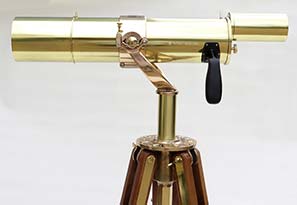
|
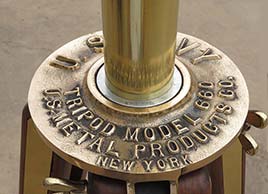
|

|
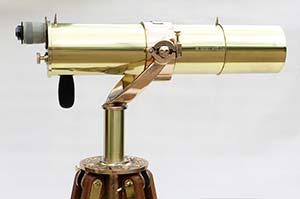
|
Page 4 of 7
Pages « 1 2 3 4 5 6 7 »

